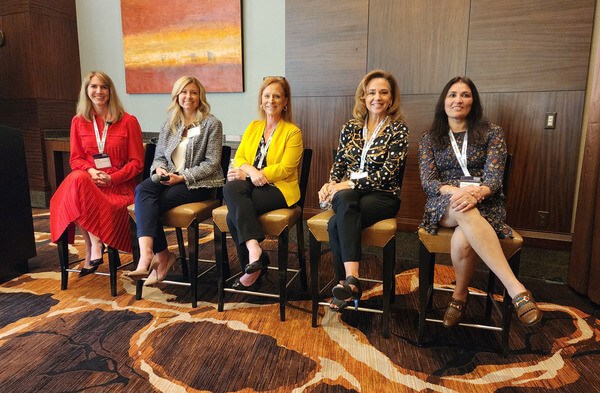Qventus recently hosted an Innovation Panel featuring female leaders in healthcare to foster dialogue around innovations in the healthcare space. The panelists included leaders in surgery and healthcare operations, and the discussion explored what innovation really means and the barriers that must be overcome to achieve meaningful innovation. This blog post summarizes the panel discussion, which took place for a live audience of about 40 surgeons and healthcare executives at Qventus’ Innovation Weekend in September 2023.
Meet the Panelists:
Ashleigh Gerhardt – Ashleigh is an ER nurse by background, and currently serves as Vice President of Network Operations at HonorHealth in Arizona.
Tammy King-Jones – Tammy is the Associate Vice Chancellor for Clinical Operations and the Chief Officer of Perioperative Intervention and Imaging at University of Arkansas for Medical Sciences (UAMS).
Karla Perez – Karla serves as Regional Vice President of Universal Health Services (UHS), a Fortune 500 company that operates hospitals, acute hospitals and behavioral health hospitals across the United States and in the UK. Karla oversees 9, soon to be 10, hospitals in Nevada.
Rahila Essani – Dr. Essani is a triple-fellowship trained colorectal surgeon based in Austin, Texas. She pioneered same-day discharge for colectomy patients, which reduces length of stay and helps patients get home sooner after surgery.
Defining Innovation
Innovation is often a nebulous concept which different people define differently. To better facilitate this panel discussion, each panelist defined innovation in their own terms. And out of that, there were several common themes.
Innovation requires risk taking and new ways of thinking about a problem. At its core, innovation is about coming up with new ways to solve existing problems. As King-Jones from UAMS put it, “Innovation is always thinking about how to do something differently, better, and more streamlined; asking hard questions and not being afraid of answers that aren’t easy … I absolutely cannot stand manual processes. So that’s kind of what’s driven me and my team at UAMS to look for ways to do things smarter, to help our patients and our surgeons.”
Dr. Essani shared that innovation can stem from unique challenges, specifically during the height of COVID when she single-handedly spearheaded same-day discharge for colectomy patients. With the COVID policy in effect, and staffing challenges creating a lack of beds, Dr. Essani knew a creative solution was needed to care for her patients who were grappling with delays and reschedules. Specifically, an oncology patient who was rescheduled twice but needed life-saving surgery. Dr. Essani urgently moved up her patients timeline, and 6 hours after surgery she checked her patient into a hotel across the street where they were able to rest and recover closeby. As Dr. Essani put it, “We realized that we keep the patients in the hospital partially to make ourselves feel better, but now 50% of my patients actually go home 6 hours after a colectomy, which was unthinkable a few years ago.” Dr. Essani’s unique way of solving a problem challenged long held beliefs about how long patients needed to remain in the hospital, and now same-day discharge for colectomy patients has spawned a movement nationwide for same-day colectomy procedures.
Innovation is a long and iterative process, it doesn’t happen overnight. While innovation may often seem to be a sudden change caused by a spark of genius, in reality it is a long process that results from dedication to a problem and a goal to continuously get better. An example of this, shared by Perez from UHS, relates to construction of new hospitals. Perez has led the construction of six new hospitals. After building each one, she took the opportunity to reflect on what worked well, and what she would change in the future. With each new hospital, incremental improvements were made, and areas that posed challenges before were now able to be handled more easily thanks to her past experiences. Now, at her sixth hospital, she says they are really thinking outside the box and asking, “How do we use technology to improve the quality of care that we deliver?” One example that Perez led is installing UV lights in the ceiling of new ORs, eliminating the need to manually wheel in separate UV lights to disinfect the room, decreasing turnover time and improving efficiency. They also have begun putting antibacterial materials in more places – e.g. doorknobs and curtains – to help further decrease the spread of infection. When applied to a new hospital, this type of attention to detail and incremental innovation can have a major impact on improving efficiency and quality of care to a large set of patients.
Technology enables us to innovate faster, but only if people and organizations push for, and support, new innovations. The rapid pace of change in technologies like connected systems, artificial intelligence, and data analytics has created an enormous wealth of information that was previously unavailable. However, without the right people in place to make sense of that information and apply it to the right use cases, it is just noise. The panelists highlighted the possibilities that technological advancements allow for, but also stressed the importance of the human touch in order to enact meaningful change. King-Jones from UAMS highlighted this point, “I think one of the areas that we need to keep pushing forward, I feel the pressure of it as we build a new surgical hospital, is really strategically ‘How do we utilize our time?’ I have surgeons that say, ‘well, you know, it looks like my utilization is good but maybe I overran or you’re comparing me to someone who overran and I finished quicker. So why is my utilization worse if I’m finishing it?’ It’s all of those questions, and everyone is trying to figure out how do we really maximize our time, and what does that look like? I think there have been a lot of strides made. Qventus, obviously, has some really good tools for that. But there’s got to be more work done. And as we think about growth, what services do we need to grow? What procedures do we need to do?”
In King-Jones’ example, the Qventus technology makes a lot more data available to her and her team. However, it’s the push for constant improvement, and asking the right questions with the right goals in mind, that actually make the technology as useful as it can be. The right combination of technology and people is essential for making data-driven decisions that result in innovative improvements.
Barriers to Innovation
Even the best ideas have to get past a lot of hurdles before they’re accepted and able to be implemented. This is especially true in large, well-established systems where change takes significant time and resources, and may face push back from many different sources. When our panelists were asked about the main barriers to achieving innovation, the most common answers were the status quo and financial considerations.
The Status Quo
- “This is the way we’ve always done it.”
- “If it’s not broken, don’t fix it.”
- “How do you know that will work?”
These are common push backs for someone trying to suggest a new idea. When organizations have done things a certain way for a long time, there’s a sense of safety in continuing to operate that way. They have a good idea of what it takes to do what they’ve always done, and a good idea of what the results will be if they continue doing what they’ve always done. Overcoming this inertia is a major challenge when trying to institute innovative ideas, especially in large systems.
To overcome the status quo challenge, Gerhardt from HonorHealth recommends making innovation a natural part of the organization’s culture: “It starts at the top with our executive team and we ensure that we’re driving innovation at all levels. We started an Innovation Academy back in 2018, we built it into our core values, and we have programs that our front line staff and physicians can participate in to make sure that we’re living out that value.” By deliberately encouraging innovation at all levels, it creates an organization that is more accepting of change.
The importance of getting involvement from all levels of the organization was echoed by King-Jones from UAMS. In her view, making sure that all key stakeholders, especially those who are closest to the problem, are at the table having these discussions fosters more innovation. For example, if a hospital is trying to improve OR scheduling, surgeons and OR schedulers need to be part of those discussions. They are the ones who live in that world daily, so they have a unique perspective on the best ways to solve that problem and will take into consideration factors that other people may not.
Financial Considerations
It’s no surprise that cost/return on investment (ROI) can be barriers to innovation. Every industry needs to consider the financial impact of its decisions, and healthcare is no exception. Even if an innovation is poised to have a very positive impact on patient care, or employee satisfaction, that must be balanced against its cost. Fortunately, there are several ways to overcome financial objections when attempting to implement new innovations.
Having a clear understanding of the ROI of whatever initiative you are proposing is essential. If you are suggesting that a health system implement a new technology, you should be able to clearly state what that technology will help accomplish, and what the financial impact will be. In many cases, the technology provider should be able to help you create a business case that explains the ROI and the assumptions that were made to reach that conclusion.
Even if you have a compelling business case, there may still be hesitancy. As Perez from UHS puts it, “Even if you can see on paper that there’s a clear return on the investment, sometimes just getting people to trust that that’s going to happen is difficult. And there’s always the, well, what if it doesn’t work, what if it doesn’t happen? Now you’ve got all this sunk cost.” It’s an important point, because ROI on paper does not always translate to real ROI – there are additional factors like the health system’s ability to implement new technology, or the human element of, “will it actually be adopted?”
To address that, Gerhardt from HonorHealth recommends starting small: “I would add, you know, resources are limited, financial resources, people resources. And so you can start small, you need to celebrate those small wins and then really build up and have the right people at the table. You’re not always going to have everyone buying it, but it’s about selling it and tying it back to them. How is this going to ease your workflow? What does this mean for you? And so I think if you have a team that can do that and really communicate then it’s a little bit easier.” Starting small will look different for different innovations, but in the example of a new technology solution, starting small might mean rolling it out at one facility instead of the whole system, or rolling it out with one service line first then expanding. Starting small not only helps you prove the financial impact, but it also makes it easier to implement and gives you a framework you can follow once you’re ready to implement it more broadly.
The financial factor is always going to be a challenge, but by measuring the expected results and putting a plan in place for how to achieve them, you put yourself in a better position to drive the change you want to drive and overcome the financial hurdle.
Conclusion
Thank you to the panelists who participated in this impactful discussion. As the healthcare industry struggles with rising costs, staffing shortages, and other challenges; health systems and provider offices must continue to innovate so they can overcome these challenges and continue providing quality patient care in the communities they serve.



